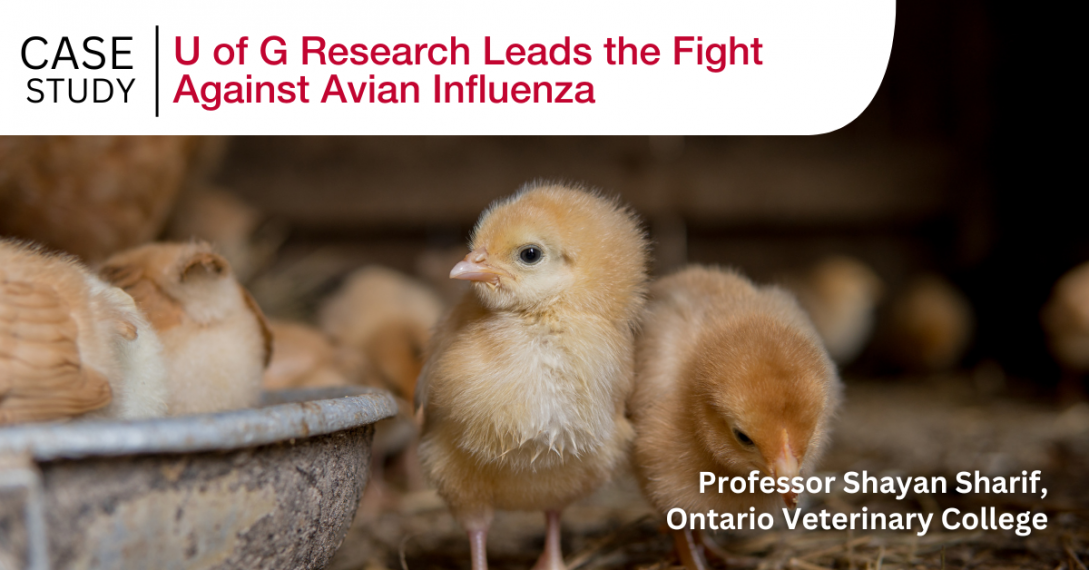U of G research leads the fight against avian influenza

In early 2024, an outbreak of avian influenza virus (AIV) in U.S. dairy cattle prompted a burst of alarming news headlines and calls for action in the scientific community.
Up to this point, nobody knew the H5N1 strain of influenza could spread to cattle—though it had already devastated poultry flocks around the world and was known to circulate among hundreds of avian species and about 50 species of mammals.
Studying the Avian Influenza
At his lab at the Ontario Veterinary College, University of Guelph, professor Dr. Shayan Sharif and his research team approached their study of avian influenza with renewed urgency. His research is funded, in part, by Food from Thought and the Ontario Agri-Food Innovation Alliance, a collaboration between the Government of Ontario and the University of Guelph.
“In terms of risk for animal populations, this is not a hypothetical issue anymore,” said Sharif, a leading expert in avian influenza.
“This is a matter of clear and present danger and risk to our food sources, to our ecosystems and to human health. This is time to do something about it.”
The recent H5N1 outbreak in dairy cattle followed a series of deadly infections in Canada and the U.S. that required culling more than 111 million poultry and cost producers hundreds of millions of dollars. In the United States, poultry prices also sharply increased, creating food security risks for consumers already grappling with the effect of soaring inflation.
Sharif and his partners at U of G have been at the forefront of global attempts to predict, contain and prevent the spread of avian influenza. Their comprehensive, multi-faceted approach has led to the creation of novel vaccines, identifies outbreaks before they happen, and helps both policymakers and industry stakeholders develop better mitigation strategies.
“This is not something related to one discipline,” said Sharif. “It’s a grand challenge, and it requires a multifaceted approach.”
Using Social Media & Google Trends to Accurately Predict AIV Outbreaks
In one notable project, Drs. Sharif and Rozita Dara, professor in the School of Computer Science at U of G, used social media activity and Google search trends to accurately predict avian influenza outbreaks long before they were officially confirmed.
This project, funded in part by Food from Thought and the Alliance, used machine learning to sort through Twitter comments, search engine data and other social media activity to identify sincere, concrete references to bird flu among the general population.
“We’ve found out that farmers, producers and public at large, and also public health or animal health authorities, start tweeting about the issue ahead of time,” said Sharif.
“Approximately one week to 10 days, sometimes even up to two weeks, there is a huge amount of activity around a potential avian influenza outbreak that has yet to occur.”
Additional research, also supported by Food from Thought and the Alliance, uses advanced algorithms to simulate virus transmission under experimental conditions. These simulations are being combined with laboratory and epidemiological data to develop an artificial intelligence-powered decision support system (DSS) to help policymakers and other stakeholders make prudent choices in the event of an outbreak. This research has been led by Dara and has already led to the creation of a prototype DSS for avian influenza, which is now being expanded and tested.
Sharif’s other studies have contributed to our understanding of how avian influenza viruses behave in response to vaccines and how they spread among poultry when vaccines are used. In this regard, the Sharif lab has developed and tested several generations of vaccines and routes of administration of vaccines. For example, the group is working on avian influenza vaccines to be administered to chick embryos before they hatch. This has the potential to dramatically reduce the cost of vaccination and also increases accuracy for vaccinations.
Altogether, the work funded by Food from Thought, has been among the most impactful research on avian influenza anywhere in the world.
“The University of Guelph has become one of the main hubs, as a broker of knowledge in the area of avian influenza,” said Sharif.
He noted the support of Food from Thought, as well as the Ontario Agri-Food Innovation Alliance, have enabled this research.
“This sort of complementarity between the two initiatives has been absolutely critical, not only for my research, but for many other researchers’ work,” he said. “It’s been absolutely indispensable.”
Looking to the Future
As Sharif and his partners move into a new funding cycle, their research continues to use artificial intelligence to mine data sources and predict, control and prevent the spread of avian influenza. One focus is creating a dashboard that synthesizes vast amounts data into a simple, easy-to-understand visual interface that can help decision-makers make better choices.
The stakes of this kind of research are incredibly high. Although H5N1 has not infected a large number of humans, Sharif notes that all human pandemic influenza viruses in the 20th century had genetic segments from avian influenza viruses.
If avian influenza pandemic spread among humans, it could result in millions of deaths, and close to $3 trillion in economic losses, according to some estimates. Food security risks remain an ongoing concern, since poultry meat and eggs are dietary staples; and H5N1 is already active among several endangered avian species, including the California Condor.
“What we want to do is ensure that this virus is countered,” said Sharif. “We are looking at a potential pandemic in the face, and we need to do something about it. The need is now.”
This story was originally published by Food from Thought.